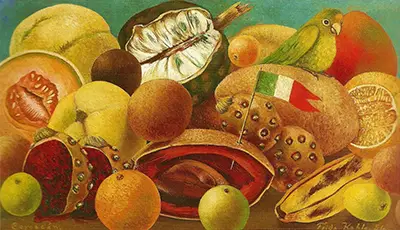Via Colonel Galeria Arvil, this artwork now resides in the Museo Dolores Olmedo (based on the collection of the businesswoman of the same name), an art museum in Mexico City, the capital of Mexico. The picture follows Kahlo's Naturalism/Primitivism style in her so-called Naïve Folk Art period. After self-portraits and portraits, the third most important genre in Kahlo's oeuvre, her total body of artistic creation, were still-lifes, and in the 1950's she was prolific, painting many of them. From 1951-54, her own image, so common before, virtually disappears from her work.
As always, Frida seeks inspiration from the exquisite natural world of her beloved homeland, for a composition crammed with a plethora of intricately detailed sumptuous local fruit, and a native parrot, all expressed in vibrant colours and representing Nature's bounty. Kahlo's paintings are very rarely just simple depictions of the world around her. They usually act as expressive vehicles for her well-known sophisticated manner; they demand that the viewer delves deep beneath the surface to reveal hidden meanings, rich symbolism and complex ideas. Here, the Mexican national flag is embedded in the rind of some tropical fruit, signifying Frida's renewed interest in the nationalistic politics of her country.
These were harrowing times for her independent nation because of a raft of race, class, gender and identity issues still confronting a young postcolonial society. Kahlo was very keen to emphasise her political convictions throughout her art. She once stated, "I must struggle with all my strength to ensure that the little positive my health allows me to do also benefits the Revolution, the only reason to live.". She was truly a zealot. In addition, there is obvious sexuality permeating this painting with images of innocent fruit transformed into exposed succulent flesh, directly suggesting erotic pleasure. The shape of the female pudenda is clearly outlined in three locations.

